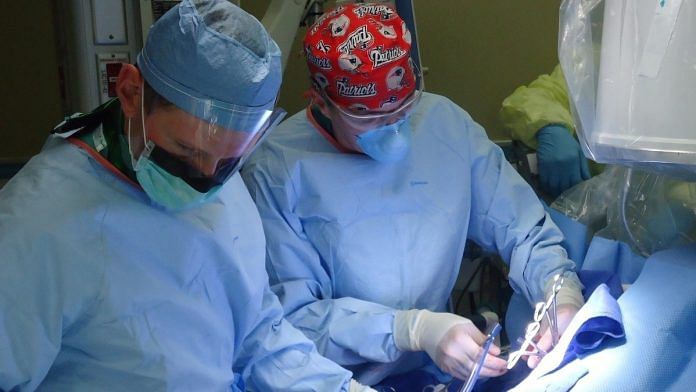Bengaluru: A young Covid-19 patient in her 20s received a successful double lung transplant, in a ‘first’ of its kind surgery to treat Covid-19, in the US. The woman had been healthy otherwise, but her lungs seemed to have been completely destroyed by Covid-19.
The surgery took place last week at the Northwestern Memorial Hospital in Chicago and took 10 hours, several hours longer than originally anticipated, to complete. The surgery was reportedly even more difficult as the woman’s lungs were “completely plastered to the tissue around them, the heart, the chest wall and diaphragm”, according to the surgeons.
The hospital Thursday reported the surgery, which was led by its Indian-origin surgical director, Dr Ankit Bharat, the chief of thoracic surgery at Northwestern Medicine.
This is the first known case of this surgery to treat Covid, according to the New York Times.
Also read: Moderna’s coronavirus vaccine trials move fast with final stage study next month
Lung damage in Covid-19
The patient is still on a ventilator because, even though her new lungs are healthy, the disease had left her chest cavity so ravaged that her muscles cannot support her breathing. However, she is already awake and in good spirits, according to authorities.
Bharat said the transplant was her only chance of survival due to the extreme levels of damage her body had faced, and his team wanted others to know that such a surgery could save critically ill Covid patients.
However, he clarified that this wouldn’t be safe for every patient, but only those who are young with no comorbidities.
Covid-19 is a respiratory disease that can cause severe damage to the lungs, starting with pneumonia, where the lungs get inflamed and filled with fluid. Breathing difficulty is typically experienced when pneumonia begins, and as it progresses, it could become Acute Respiratory Distress Syndrome (ARDS), a form of lung failure.
ARDS patients typically require ventilators to help circulate oxygen in their bodies and the disorder is often fatal.
For many survivors, recovery from scarred lung tissue takes anywhere from a few months to a year, and can be arduous. Many patients might require therapy and assistance for weeks or months after recovering from the virus.
Also read: US drug company Eli Lilly says its Covid treatment could be ready as early as September
Lung transplant surgeries
A lung transplant in humans was first performed in the University of Mississippi in 1963, after two decades of successful and unsuccessful attempts in animals. The 1963 transplant recipient survived for 18 days.
For nearly two decades, attempts at lung transplantation failed because recipients’ bodies rejected the new organs.
When new immunosuppressive drugs were developed in the early 1980s, patients’ immune response could be tempered and successful organ transplants performed. The cardiopulmonary bypass (CPB) pump’s invention also aided successful surgeries, where the machine could take over the function of the heart and lungs temporarily while organs are being transplanted.
The first successful long-term single lung transplant was performed in Stanford University in 1981, and the first successful double-lung transplant was performed in Toronto in 1986. Post that, the first heart-lung transplant, where a patient’s heart and lungs, both need to be transplanted because of severe cardiac disease, was performed in 1987.
Double lung transplant, or a bilateral transplant, is akin to having two single lung transplants, where one lung is first transplanted sequentially before the other. Patients are typically placed in intensive care for monitoring for a few days or weeks, along with ventilator assistance for breathing. Patients are confined to bed, and are fed through tubes. Medication is also provided intravenously.
Because nerve ends are often cut during a transplant procedure, some side effects occur during recovery, such as the inability to cough. Patients often do not feel chest congestion during recovery. So during recovery, patients are trained to breathe deeply and purposefully cough. Chest tubes are often used to drain out excess fluids.
To prevent rejection of transplanted organs, recovered patients often must continue an immunosuppressive regimen for life, at a high risk of contracting other diseases.
Transplanted lungs typically function for three to five years before they start to fail.
Also read: Indian drugmaker Lupin voluntarily recalls metformin variant, a diabetes drug, in US






